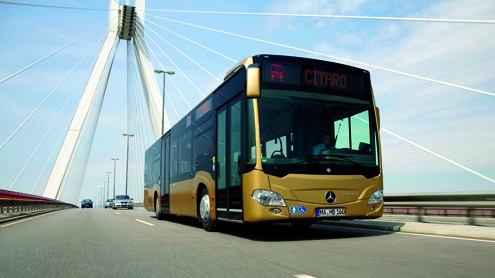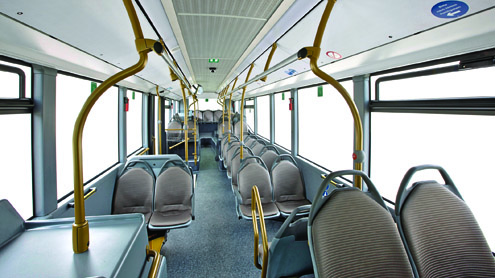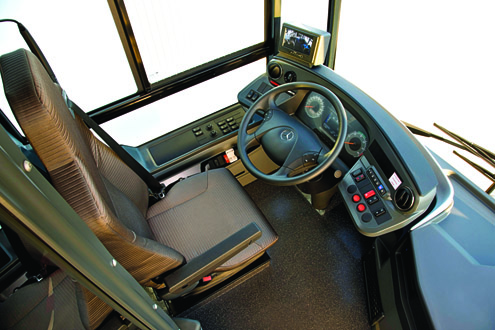

Daimler delivers a wake-up call; Alexander Dennis teams with New Flyer
By Doug Jack
I trust you will not object, but looking from my side of the Atlantic the decision by Daimler to close its Orion Bus Industries factory in Canada and New York after completion of current orders sends a sharp wake-up call to the whole of the North American transit bus industry, especially manufacturers and transit authorities.
Last year, globally, Daimler Buses built around 39,700 chassis and complete vehicles. Daimler is the oldest bus manufacturer in the world, with more than 125 years of experience in the industry. The company does not rush into decisions and traditionally has been in markets for the long haul, except when there have been serious changes in circumstances.
Daimler Buses is familiar with volatility in bus markets around the world. Sales can go up or down from year to year and are subject to many factors beyond the control of manufacturers. For instance, in good years there can be major tenders from the larger cities. In other years, there can be severe shortages of funding, as we are seeing currently in most of the countries in Southern Europe. Daimler Buses has long experience of handling that kind of volatility.
I interviewed Hartmut Schick, Head of Daimler Buses, on Friday, April 13. We talked about his company’s activities all around the world. On the subject of Orion, he simply said that the operation was losing money and was a cause for concern.
The sales figures speak for themselves with deliveries having fallen from 734 in 2010 to just 463 in 2011. Orion had enjoyed considerable success with hybrid buses, but demand was moving back to less expensive standard diesel-powered buses.
Daimler concluded that it could not turn Orion round with demand for transit buses from regional and municipal authorities across North America falling. Daimler must have decided this was not a short-term factor, but potentially a long-term problem. The fact that it has decided to close the plants will hurt its pride, but will not dent its global standing.


There were strong rumors that Daimler offered Orion to other manufacturers in North America, but they too were suffering from declining volumes. It seems clear that they preferred Daimler to depart from the market, giving them better prospects for long-term survival.
I have no doubt that Orion would have been in a far healthier position if it had been able to use a much higher percentage of standardized Mercedes-Benz components in its city bus range.
The Citaro range of city buses is extensive, including solo and articulated models with the options of hybrid, compressed natural gas engines, and the most advanced fuel cell hybrid systems in the world. The whole range benefits from economies of scale. If Daimler could have assembled the Citaro in North America, transit authorities would have benefited from an extremely well proven city bus.
As you know, that was simply not possible because most agencies procure their transit buses through federal funding and therefore must have a minimum of 60 percent U.S. content, by a combination of labor and materials. Furthermore, it must be U.S. content, not even content from the North American Free Trade Area countries.
Put at its most blunt, the Buy-America regulations are a restrictive practice. One could well make a case that they are a restraint on trade under the rules of the World Trade Organization. No doubt their introduction originally protected jobs in the United States, but that has come at a heavy price to the transit authorities.
The Buy-America policy and the Federal Motor Vehicle Safety Standards are responsible for generations of transit buses unique to the North American market that cannot be sold outside the U.S. and Canada.
For example, very few countries outside North America will permit an overall width of 8ft 6in. Most countries work to a metric maximum width of 2.55 meters, or 8ft 4.4in. The Citaro is built to this overall width in Germany, but because it has slimmer side pillars than Orion buses, the actual interior wall-to-wall space for passengers is marginally greater.
To my knowledge, Japan is the only other developed country to impose such restrictive regulations, largely by enforcing different dimensions. Additionally, right hand drive can be quite a deterrent to many potential suppliers. For instance, in Japan the maximum permitted width is 2.49m or 8ft 2in, which would involve manufacturers in very substantial re-tooling for the sake of just over 6in from the European standard. It is possible to import wider vehicles to Japan, but they require special dispensation and are limited to operation on specified routes.
The net result in Japan is that there are three manufacturers fighting over a market of around 4,000 larger buses and coaches per year. They offer a very wide range of products, including transit buses of various lengths, with the options of the floor one, two or three steps above the ground. They also have coaches at various lengths and with various deck heights, which results in very low volume manufacturing, and therefore high unit costs and high prices for customers.
Another major contributing factor to the high price of vehicles is compliance with legislation. I am not for one minute suggesting there should be any reduction in safety standards or permitted levels of vehicle emissions.
However, it is a fact that there are three main sources of legislation in the world. Japan and the United States have their own vehicle construction standards and their own limits on emissions.
In Europe, much of the legislation originates with the United Nations Economic Commission for Europe, (ECE), based in Geneva, Switzerland. The European Union often incorporates its regulations, which are also widely adopted in many other countries around the world. For instance, it was UNECE that first devised legislation on passenger survivability in the event of a coach rolling over. Australia, Spain and the United Kingdom were among the first countries to adopt this regulation.
On engine emissions, Europe, Japan and the United States are all seeking reductions very close to one another. However frustrating for manufacturers supplying global markets, there has been no harmonization of test cycles. They have had to homologate their products under each set of regulations for those markets where they want to participate. That inevitably means the employment of a greater number of highly qualified engine technicians.
Most markets outside the United States and Japan adopt European emissions legislation, but quite frequently they are two or even three steps behind the European Union in introduction. One of the main problems is ensuring that oil companies can provide the infrastructure to offer much lower sulfur fuel, which is obligatory in the latest generations of engines.
If there could be much closer harmonization of legislation between Europe and the United States, and Japan for that matter, then transit authorities would benefit from economies of scale. There are internationally excellent American suppliers who would benefit — Cummins, Allison and Eaton for instance.
In Europe, the top five bus manufacturers are all associated with major truck builders and use many common components, particularly engines. Daimler and Volvo are very established brands in the United States. The other three, Iveco, MAN and Scania, have chosen not to come into the U.S. automotive sector, although Scania has targeted the U.S. with industrial engine supplies.
One of the main deterrents to higher volumes of imports from Europe is the vast size of the United States and Canada. Setting up parts and service networks would be a mammoth task and very expensive. However, transit buses come back to the same depot every night, so service support is available wherever the vehicles operate.
Abolishing the Buy-America rules, or even reducing the percentage content, would not be a serious threat to American transit bus builders. They know their market and their customers, but abolition or easing of the rules would enable them to shop around for the best components at the most competitive prices. If they could pass those benefits on to customers, it would enable them to purchase more vehicles and bring down the average age profiles of their fleets more rapidly.
New Flyer and Alexander Dennis
There is a recent and very promising announcement in the proposed joint venture between New Flyer Industries and Alexander Dennis. The British company has 20 years’ experience building midibuses, with over 16,000 in service in various parts of the world. Alexander Dennis will develop versions of its Enviro200 range for the North American market.
I believe the plan is for Alexander Dennis to supply underframes and aluminum body structures in kit form from the United Kingdom for assembly by New Flyer. Fortunately, the Enviro200 already uses Cummins engines, Allison gearboxes and Dana axles, made in Europe, but the directly equivalent units can be sourced in the United States. No doubt New Flyer will also be able to use many U.S. components in the fitting out of the vehicles.
The Enviro200 is a purpose-built midibus, not a full size heavy-duty vehicle that has been shortened. It uses smaller wheels and tires, which gives better space for the passengers in the interior. It uses a smaller and lighter Cummins engine offering excellent fuel economy, a very important factor at a time of rising fuel prices.
This is potentially a win-win situation for both companies. It gives New Flyer a significant addition to its range and it adds to the rapidly growing export volumes of Alexander Dennis.
Fortunately, this project meets Buy-American standards already. Just think what else could be achieved and offered to transit authorities if there was not such restrictive legislation in place. BR
Doug Jack is with Transport Resources in the United Kingdom.
